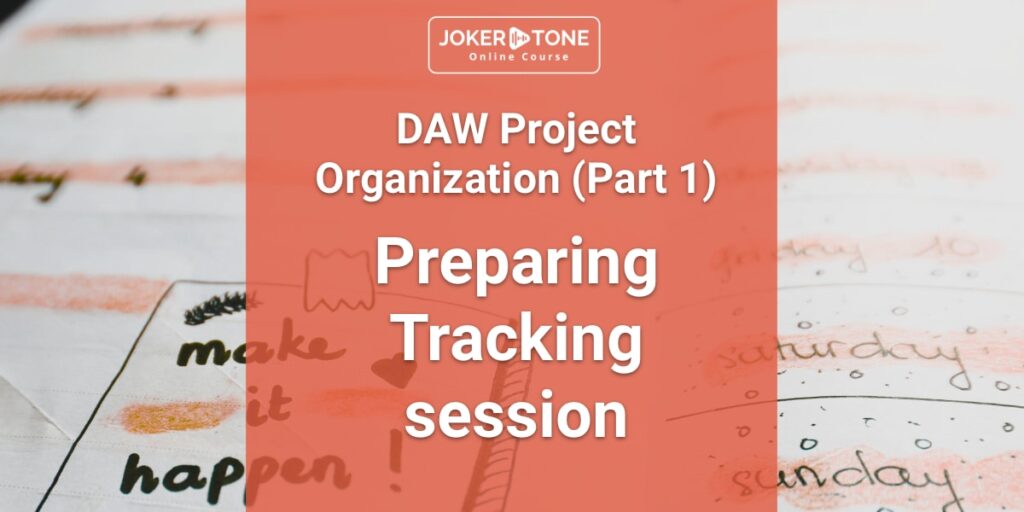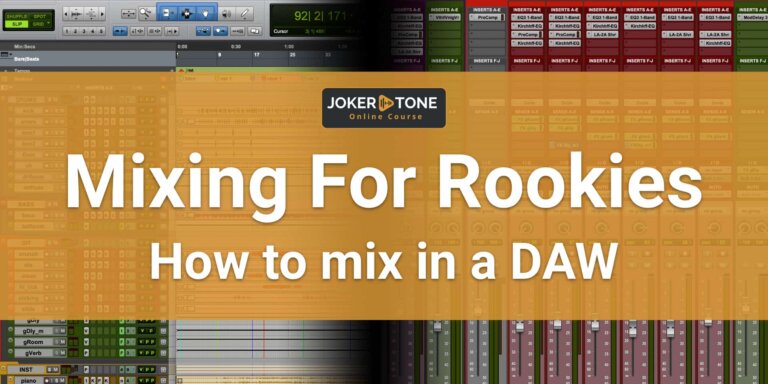Why a DAW project organization is essential
If you’re in a creative phase, such as recording, or the middle of your mix session, losing track of the project will be very inconvenient. With a DAW project organization, this won’t happen to you. It could become a standardized guide that leads you through each of your projects. It doesn’t matter how big the session is or how advanced the production process is.
There are several key aspects to the DAW Project Organization.
I have divided this topic into the following parts, each of which you will find in a separate blog post:
- Preparing a tracking session (DAW Project Organization — Part 1)
- Daw audio track naming (DAW Project Organization — Part 2)
- Color Scheme (DAW Project Organization — Part 3)
- Session Routing and Track Folders (DAW Project Organization — Part 4)
My personal basic rules for keeping an overview:
Already in the songwriting process, you will certainly come across numerous ideas and resulting different track types.
At some point, this can become confusing, and it takes a certain amount of time to find the track you are looking for, which still needs to be recorded, needs a touch-up, or needs to be included in the mix. Or you ask yourself during the session: “Was this actually the final track, or do I still have to edit it?”
None of this is conducive to the creative work and recording of a new song. Maybe you jump from one song to the next in a complex album production or record numerous tracks over a longer period. Then the slight uncertainty becomes a demotivating problem.
With DAW project organization, you can prevent this before the first recording.
When I was thinking about the topic for a blog post, I initially thought that this was “actually” a rudimentary consideration. But then I remembered my beginnings, and my DAW project organization has evolved immensely over the years. However, I must also point out that I have maintained my current structures for many years, as they have established themselves excellently and proven themselves. I would therefore like to share them with you, and perhaps these approaches will help you with your organization.
One thing should be mentioned in advance: there are no “professional standards“ or phrases like “this is how the professionals do it”. That’s just a bunch of words and certainly makes a great hook for a blog post. For the DAW project organization, personal tastes and your workflow play the most important roles. Perhaps you will also find some of my approaches logical or useful, or maybe they will just serve as a suggestion to help you realize “I would rather not do it this way, I’d rather do it differently”.
I would be happy if it makes you reflect, and you create your own DAW project organization. It will be very useful to you throughout the entire production process for many song projects.
The advantages of a DAW project organization
Let’s first look at the benefits that you get immediately with a targeted DAW project organization and with every new session.
Saving time
Saving time is always a good point or factor with which to generate attention. However, saving time is only desirable if it minimizes time that can be better spent on other productive or valuable tasks. Let’s take the mixing process as an example: I enjoy mixing a song, and I’d rather have more time for it than spend it digging through a session. Because I will lose time when I don’t know what the status of the individual tracks is, or I have to search for the tracks for a long while. If you can save time on activities that slow you down and are unproductive, you’ll have more time and enjoy the creative parts of song production.
Keep an overview with a DAW project organization
But it’s not all about speed per se. Keeping an overview is an essential factor for working on a song in a more relaxed way.
For a small song with around 10 tracks, this approach may not seem so relevant, but even then, it’s nice to be able to find the track you’re looking for at a glance.
“Modern songs” can easily have more than 50–60 tracks. From then on, it becomes a challenge to find the desired track quickly. Even if I haven’t come across it personally, I often read in audio forums about productions that have well over 100 tracks in a session. For my part, I usually don’t even have to deal with 60 tracks in a session. Typically, between 40-50.
Free up storage space if you know which tracks you can delete
If you have an overview of your session, e.g., through uniform labeling, you can quickly decide which tracks you want to keep in the final session or which can be inactive or deleted.
This also saves you storage space on your hard disk and your backup drives.
When you work together with others
If you share your session with another music partner or just exchange a few tracks with each other, everyone will be truly grateful to receive well-labeled tracks. And the labeling starts in your session. If you work together intensively on different songs, then you should also talk about a joint DAW project organization. In the best-case scenario, you will find a common basis and can create new songs together much faster.
Preparing tracking session
A well-prepared recording session will always go better than a spontaneous mess. And it doesn’t matter whether you’re recording by yourself or involved in a session with other musicians and engineers. In my opinion, there are some basic aspects that you basically only have to set up once in advance and that you can call up immediately at any time.
1. Session layout for the recording
- What information do you want to see when you record?
- Which windows and settings for the recording type should be set in advance?
- Are there certain plugins that should already be present in certain tracks?
An example: I have created a songwriting layout for “rock songs” inside my chosen DAW like Pro Tools. I don’t need a mixing window explicitly for this, but have some settings directly in the tracking window, like levels and the first six inserts. In addition, there are tracks such as drums (Virtual Dummer from Tonntrack SD3), and a bass track with a bass amp plug-in with a rock sound set directly. The same applies to a few rhythm and lead guitars, a piano track, and a few vocal tracks. These are also all already labeled as guide tracks so that I can always find them immediately and know that these were the guide tracks and not the final version.
This is a very basic preset example for a DAW project organization basis. But even if you just have small and simple presets, they will save you time and give you your project layout standards.
2. Inputs
If your interface has digitally adjustable preamps that can be saved with the session or a virtual mixer, this is also a time saver. When you don’t have this option and only use analog preamps, it helps to make a small note in the session with which setting you can start directly for the respective input. This should then also be set and saved inside the session on the respective track and become one aspect of your DAW project organization.
For example: Input 5 is set for track 7 (main vocals), and your preamp 1 gives you the best amplification for your chosen vocal microphone at 50dB.
Working with two microphones at once most of the time, you probably can remember these settings after some time. But if you set up a whole drum kit or mic up other things like a guitar amp only from time to time, these notes a such a big helper.
3. Monitoring settings and levels
Simple routing leads directly to the easy creation of monitoring paths for your main monitoring boxes or individual headphone paths. If you are in the recording phase, you will certainly want to hear the recording channel a little more clearly than when you are assessing it in the mix. Different volume levels are helpful for this, and you can get these excellently via separate monitoring paths. You can also save these as presets in the DAW and load them quickly into the respective session if required.
Decide for yourself which kind of level you want to start monitoring your song through your speakers and your headphones. Leave some headroom and don’t start too loud for your normal reference level.
Tracking Sheet
The tracking sheet is such a powerful tool if you know how to use it sensibly throughout the entire production process. Writing down a list of which instruments are to be recorded is a simple task. But if you go one step further and create a useful table or matrix from this, the tracking sheet can be very useful in the planning of the recording. It will go further to the completion of the production and be one main part of your DAW project organization.
The tracking sheet can not only accommodate the individual increasing tracks. It supports you in the time planning and sequence for the recording, serves as notes for settings and comments during the recording, and is the checklist for a good feeling of not having forgotten anything and making progress. For mixing, it can also serve as a checklist and store all the information and notes from everyone involved in your production, including possible first test listens before release.
I recommend you look at my blog post on the tracking sheet. There you will find all the useful tips on how to create and use your tracking sheet. I also offer you a free template that you can use directly for yourself.
Conclusion
If you take a closer look at these hints and tips from this blog post and try to embed them in your production, you will quickly see that the organization and implementation will simply be more relaxed. I am also sure that you will save a lot of time, which you can certainly put to much better use in other areas of your creative process.
Please reach out to me if and which practices have helped you the most in the preparation of your recording session.
If you have further questions or want to get in contact, please consider using the contact form
Niels from Joker Tone Course




